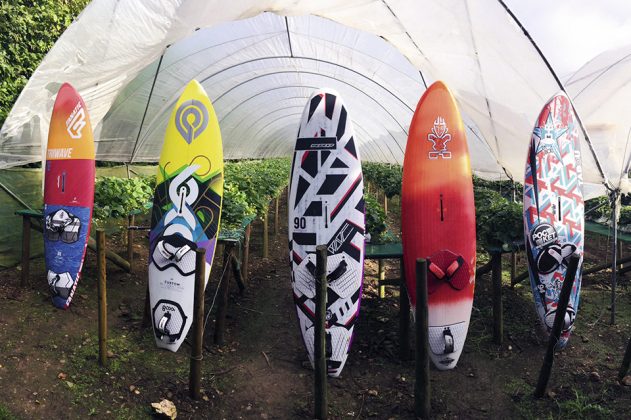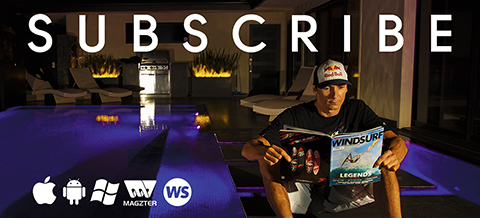FRUITS OF SUMMER
90L WAVE BOARD TEST 2016
Test Editor Tris Best // Second Testers Maurin Rottenwalter, Joe North
Photos Nick George // Test Location Southwest England
Wave board design continues to evolve and there are certainly some interesting aspects to each design in this group. A squared swallowtail and double wingered swallowtail to name just a couple of interesting tail shapes.
This test was originally published in the October 2015 issue.
You then have a massive array of bottom shape configurations used, from the conventional vee / double concave to pronounced mono-concaves, not to mention the massive disparity in rail sharpness / tuck between the boards. Then there are the fin options, from the thruster majority in the line-up to a quad and a twinzer, adding a bit of flavour to the test. All the boards here are supplied with one ‘recommended’ fin setup, but several can obviously be used in another configuration.
The Starboard can be used as a single-fin board if preferred; the Goya as a twinzer… and the RRD as pretty much anything you like with its five slot boxes! As with the stubby boards tested elsewhere in this issue, you’d do well to take your time and experiment with the fin placement of each of these boards. Whilst they aren’t quite as fin sensitive as their smaller siblings, the fin’s position, along with footstrap and deck plate position, can make a massive difference to the feel and response of the board.
This test was conducted around the UK shores, from south coast cross-onshore conditions, to Cornish cross-offshore bliss. If you speak to some of the Cornish locals, the response is that the summer has been pretty lousy for conditions, with little swell or wind. Yet, for testing we scored some ideal days. Nothing too big that it becomes a test of your own ability more than that of the equipment, but consistent waves and wind to give the boards more than a fair crack of the whip. The advantage to conducting the test around our own beaches is that we could get a sense of their ‘real world’ appeal for our own market and the conditions that you, as readers, are likely to experience. So we are pleased to report that all five boards are equally applicable to the conditions found around our shores as they undoubtedly are in the locations from which they were developed, be that Maui, WA, South Africa or south of France.
FINDINGS
If we travelled back in time and took a snapshot of a wave-sailor’s board quiver through the years, it is likely that you’d always ideally find at least two boards in their line-up – one for nuclear wind days … and the other as their trusted stead for use in the majority of conditions. The big difference in a modern board quiver today is the size of the boards – whilst 80-85L is the ‘go-to’ wave board size for most, the ‘extra’ board tends to be larger board today, rather than smaller. No longer the big boy’s wave board, the 90+ litre platform is desirable for most, the change in consensus coming with the introduction of multi fin setups. With a larger volume, float and ride sessions are no longer the sole domain of the tightrope-walking super-fit. You could plane earlier and boost over rushing white water easily, yet still have a small, compact and responsive board underfoot once on the wave face. These boards are super playful when going … so much so, that we wouldn’t be surprised if they steal the 85L wave board’s thunder and become the wave-rider’s mainstay board size in the future.
SUMMARY
There is a proper mixed bag of styles and performances on offer from these five boards. The Fanatic is the most conventional, offering phenomenal plug and play ability, whilst remaining fun and capable on the wave. Similarly, the Starboard Kode Wave has fantastic crossover appeal into a coastal bump and jump role, being fast and super stable, both in a weight carrying capacity and directionally. The Tabou and Goya are unquestionably wave-biased, the former being smooth and easy whilst the latter represents the sharp edge of wave board development in every way. Last up is the RRD, which has an almost hybrid look to it, with its squared swallowtail and boxy nose outline. It is the result of some investigation down the stubby route by the brand, matched with a steadfast understanding of their unwavering brief for the Wave Cult to offer‘all-round’ performance. And in our opinion, the result is well worth a look.
TEST LOCATION
This test was conducted around the UK shores at more than 6 wave sailing locations. UK conditions can certainly be unpredictable at times, yet with a good summer of wind, we had time to test the boards and sails at a variety of locations and in a mixture of conditions, from cross-onshore to firing cross-off.
uk.otc-windsurf.com
THE LINE UP



